
Diamond Settings

Gemologists are joking that the jewelry set is a “graveyard” for a diamond, even for the most beautiful one. There is a kind of philosophy in this joke. Literally, the jewelry is a final destination point of a diamond. Unlike any other “grave,” diamond mounted into a piece of jewelry symbolizes the beginning of something new: newborn life, new relationships, the latest status of marriage. The fresh, sparkling, and beautiful beginning. The diamond engagement ring became a symbol of a new life for two in love. We bring her a diamond when she brings us a new life with a baby. We present diamonds jewelry as a New Year gift, a Birthday, or a Christmas gift. The only holiday we bring her diamond not connected with the new beginning is Valentine’s Day, but this doesn’t stop men from buying Heart-shaped diamond pendant as a symbol of love.

So, what are the settings or mounting? It is the way of securely attaching the diamonds or any other precious stones into jewelry. There are seven major types of stone mounting. We’ll throw every type of stone setting to help you figure what exactly you need. First of all, let’s take a look at center stone settings:
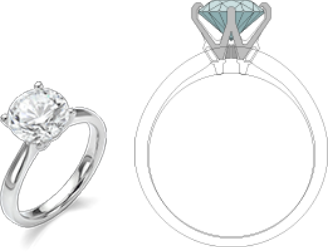
It is the most popular setting for the engagement ring, designed by Charles Tiffany at the end of the 19th century. Usually, 4 or 6 prongs are used to set the stone. Without wasting words, let’s see what is really important:
“+” Open setting exposes the diamond to the penetrating light by more various angles increasing the brilliance, sparkle, and fire and, as a result – enhance the beauty of the stone.
“ - “ Prong setting might be bent by inadvertent damage, which increases the risk of stone loss. What should you pay attention to? The thickness of the prongs and the quality of the mounting. Prongs mounting shouldn’t snag on clothing. We advise you to look for a 14-carat gold or platinum ring.
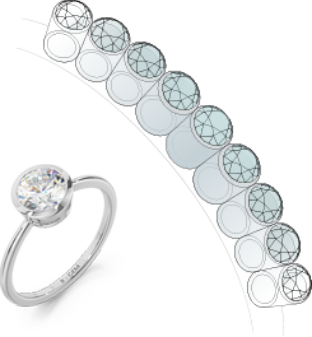
It’s the most antique technic of gemstones mounting, very similar to a flush setting. The diamond is usually placed inside and secured by pressing the metal over the girdle edges.
“+” The most secure way of diamonds mounting. This kind of setting protects the diamond best way from unintentional damage.
“-“ The diamond receives less light from the pavilion. The setting makes the diamond look smaller. How to avoid it? Diamond set into a higher stone-shaped basket may increase the visual size of the stone.
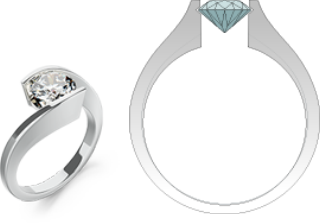
This kind of setting requires no prongs, bezel, or basket. The diamond is pressed down inside the grooves on two sides of the ring walls by the metal's natural spring-loaded tension. It creates a fully floating effect, looks like nothing holds the diamond. The stone receives plenty of light, giving it a stunning look. The tension ring is always built for a specific stone. The spring-loaded effect doesn’t allow to resize the ring, and it will remove natural metal tension. Excessive tension might damage the diamond. Every tension ring is custom-built by the exact diamond size dimensions—no other options. Instead of the visual fragile of tension setting, the diamond is well secured and protected. The only strong impact can damage the metal's spring-loaded effect, leading to the diamond's drop-off. Well, a strong impact may affect and damage other settings as well.
“+” A stunning look. Excellent protection of diamond edges.
“-“ The ring cannot be resized. What should you pay attention to? Look for a very highly skilled professional. If a jeweler or a seller offers you to set your diamond into an existing setting – run away, avoid losing your money and diamond. A lightweight ring with thin walls is not an option. It maybe looks lightweight, but it will not keep your stone safe.
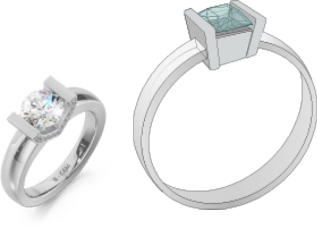
Visually Bar Setting looks similar to a Tension Setting. The diamond is secured between two bars. But unlike the tension setting, the bar setting has no spring-loaded effect. Two edges of the stone are placed into special grooves. In some designs, there is a unique groove for the culet. “+” Wide bars provide proper protection and excellent visibility of the diamond. “-“ without culet groove, diamonds are less secured. What should you pay attention to? Thick bars.
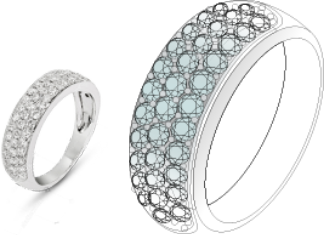
Pave in French means pavement, and it represents the meaning of this setting. Short prongs or droplets of metal secure small diamonds, encrusting the surface. This technic increases the brilliant effect of whole jewelry. “
+” well tighten prongs keep diamonds secured. Encrusted surface increases the overall brilliance of the jewelry.
“-“ it requires very skilled work; otherwise, snag on clothing is guaranteed. How to avoid it? Check for free loose stones in a pave setting; it will sign low-quality applied stones.
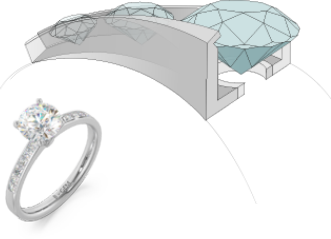
It's the so-called non-prongs setting. The same size diamonds are held in a space between rails inside two parallel metal walls. No metal prongs between the square-shaped diamonds (like princess and baguette shape) create a continuous sleek of diamond's surface. The absence of space between the stones avoids dirt getting inside the channel. Side by side-channel set round diamonds, without prongs, creates a beautiful floating effect of the stones inside the setting.
“+” An excellent security and the best protection is possible for the diamonds, set into a channel setting.
“-“ Actually, there is no shortcoming.

An invisible setting is the most beautiful, expensive, and complicated technic of a diamond setting. It requires to fit the shape of stones scrupulously and curve special channels into the pavilion, the bottom of the stone. Regular cut diamonds cannot be used for an invisible setting. The invisible setting creates a solid diamond surface with no stone mounting signs like nothing holds the jewelry's stones. You can find that all diamonds mounted into special metal frames hold the stones on the curved channels under the surface. Diamonds in the invisible setting are sensitive to physical damages.
“+” Stunning look.
“-“ The price. Specially cut diamonds and complicated frame handwork affect a high price. It is hard to find a service point for this type of setting. A regular jeweler is not able to fix invisible setting jewelry. The repair rates are very high as well. What should you pay attention to? Look for a highly-skilled and expensive jeweler. In the tight setting, no loose stones are allowed.
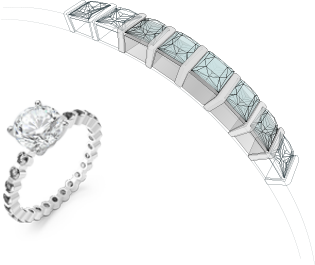
Like the center stone bar setting, each diamond is placed and secured by two bars, and special grooves secure culets. In some cases, the whole pavilion may be hidden into a grooved “basket.” Exposed sides of diamonds increase the play of light inside the diamonds.
“+” Beautiful look. Diamonds are secured.
“-“ Short or thin bars will reduce the protection of the diamond. What should you pay attention to? In the tight setting, no loose stones are allowed.

Similar to the center stone Prong setting, diamonds are held by four prongs, securing the stones.
“+” Open setting lets the light penetrate the diamond by various angles, increasing the brilliance, sparkle, and fire and, as a result – the beauty of the stone.
“ - “This mounting provides less protection due to the exposed edges. What should you pay attention to? The quality of the mounting. Prongs mounting shouldn’t snag on clothing.

It is the most popular setting among the jewelers. Small diamonds are placed inline into specially drilled holes, then metal between the stones is cut in the middle. Divided metal moves to the sides, securing the stones from both sides of a cutting knife.
“+” An Excellent level of diamonds secure. Proper protection of the stones from damage.
“-“ An extra pressure will damage the diamonds while setting process. But this is a jeweler’s problem, not yours. What should you pay attention to? The same height must calibrate the diamonds. Non-calibrated stones break the solid look of the setting. Check if diamonds are not damaged during the setting.
So, I hope these small secrets will help you make the right choice.
Learn more




